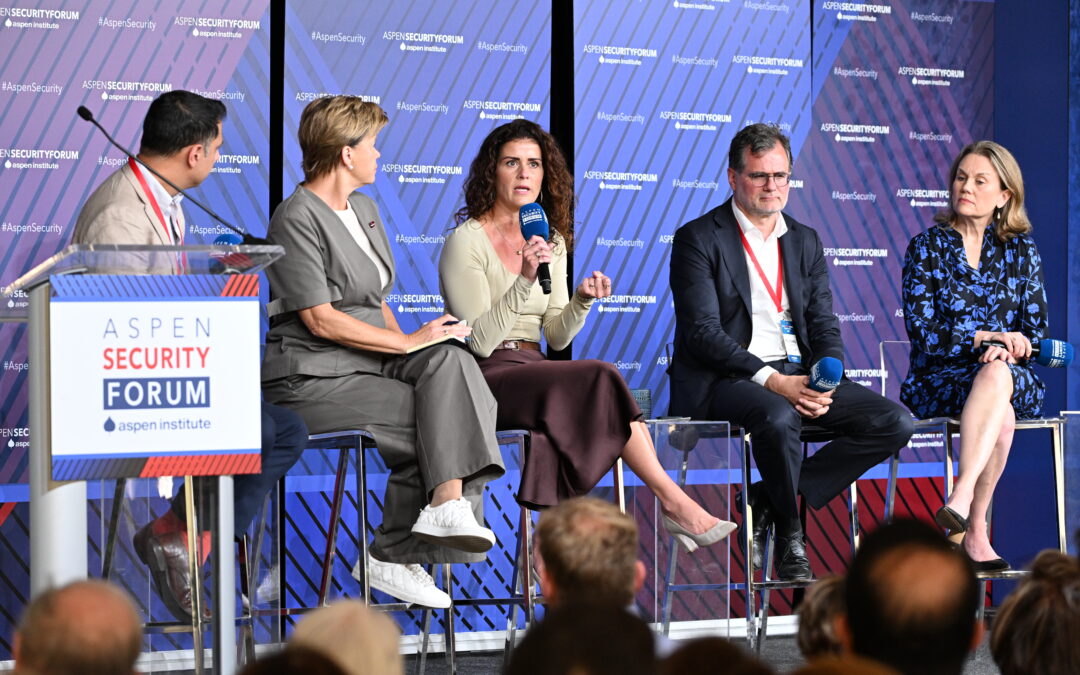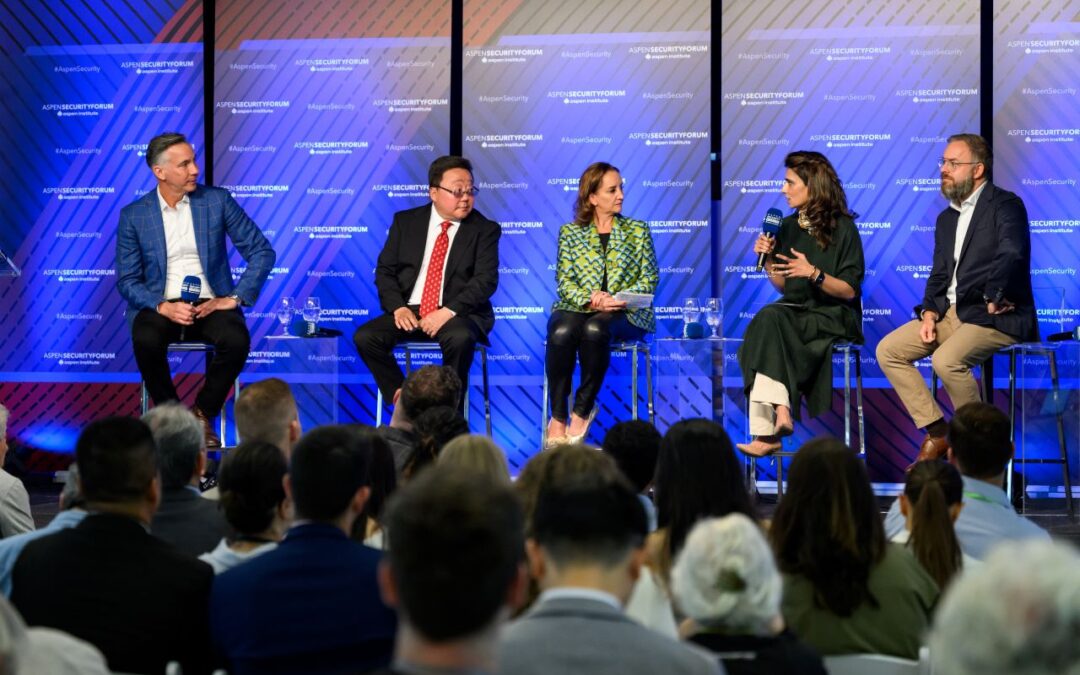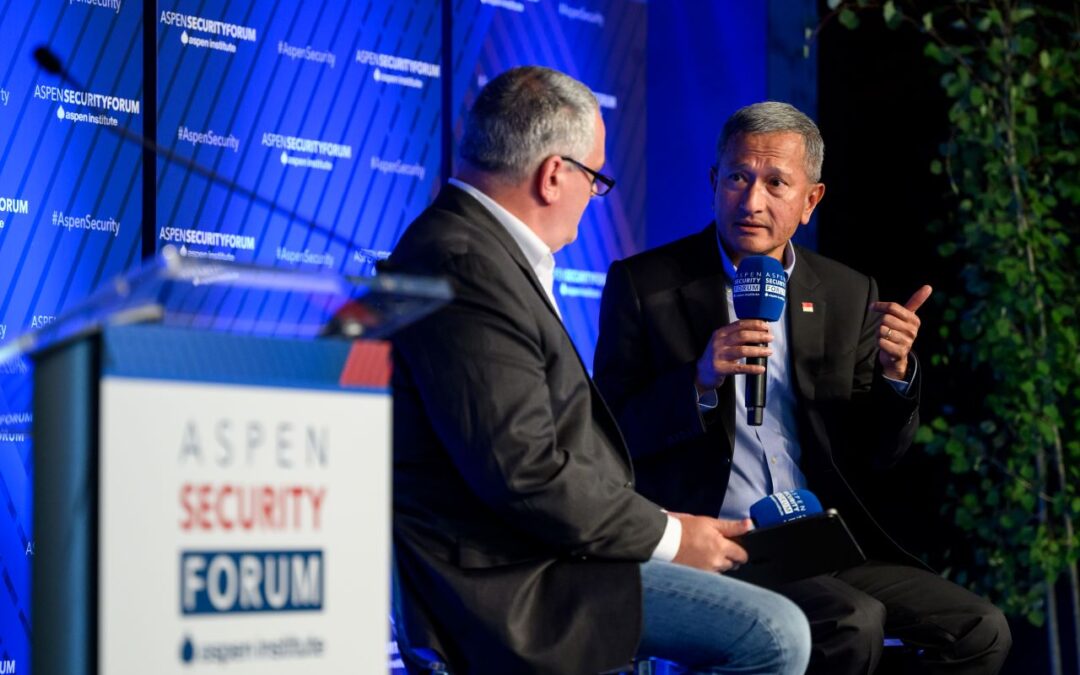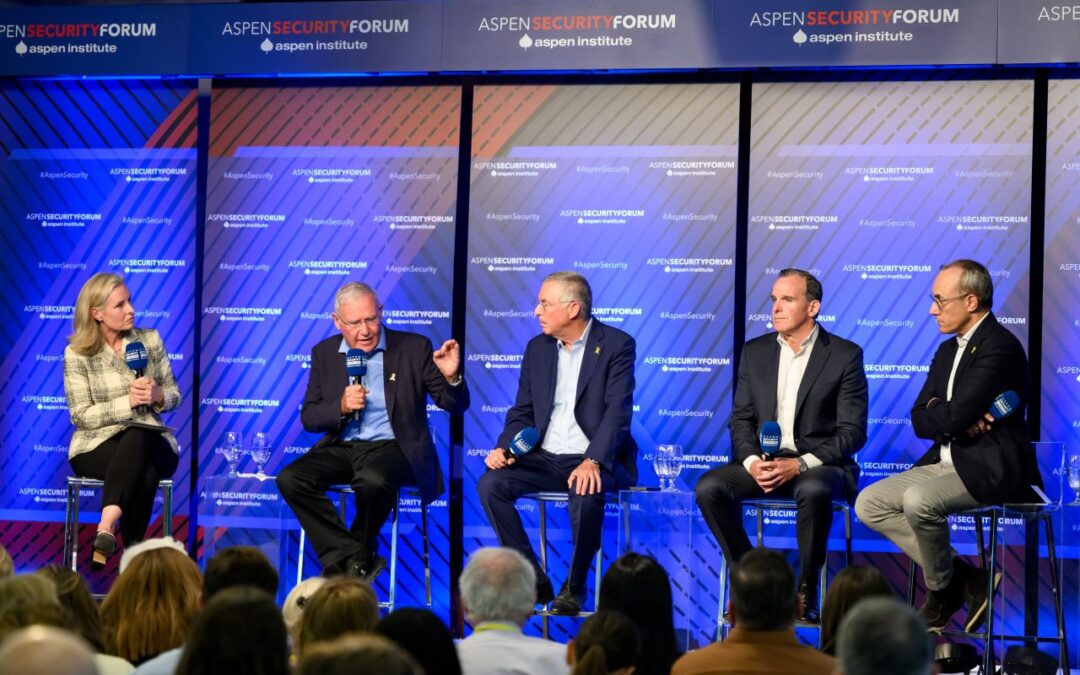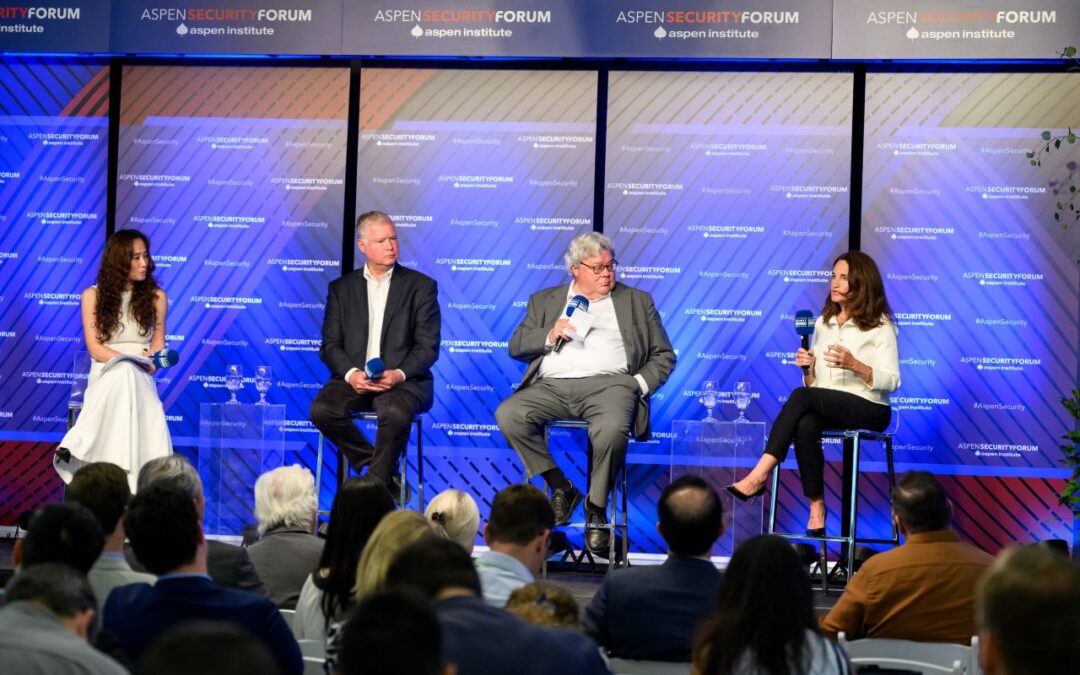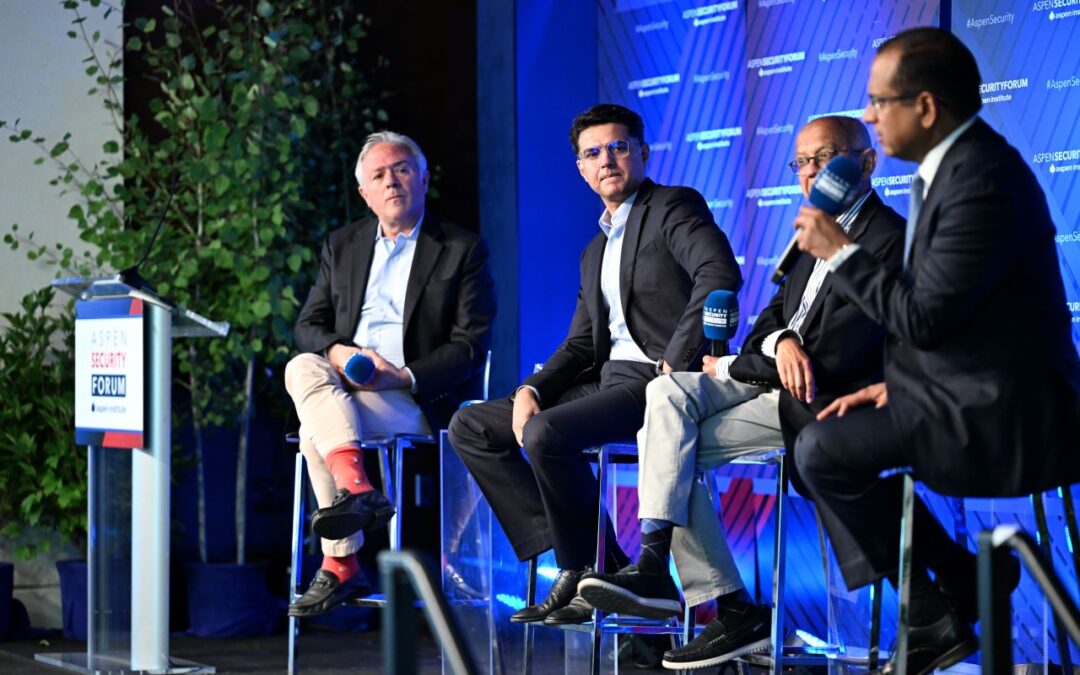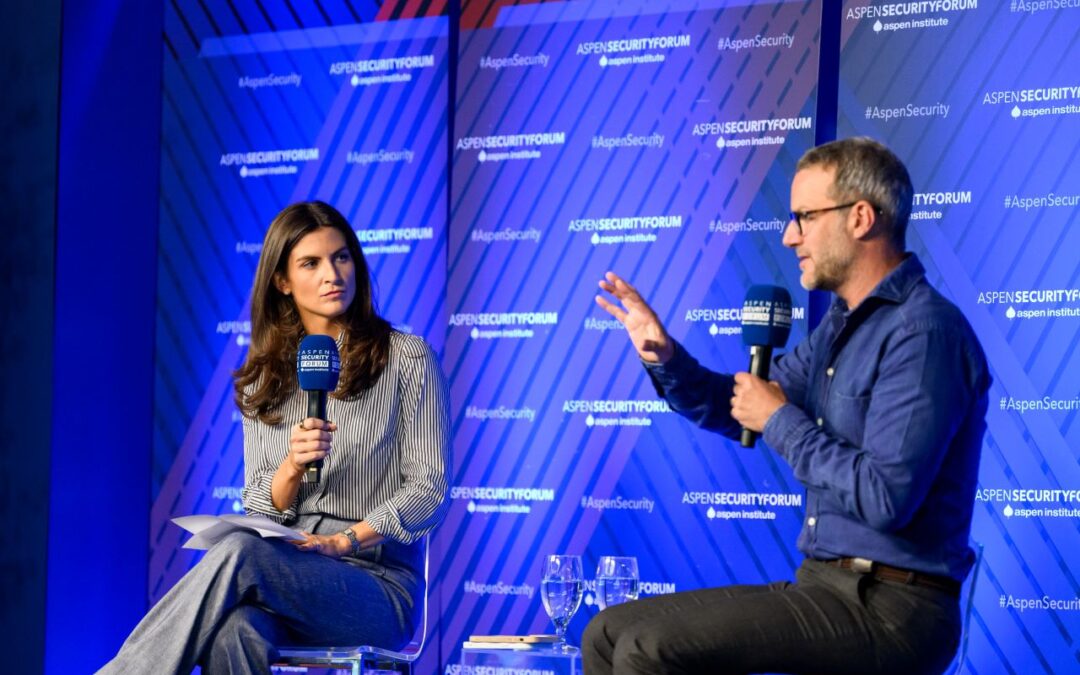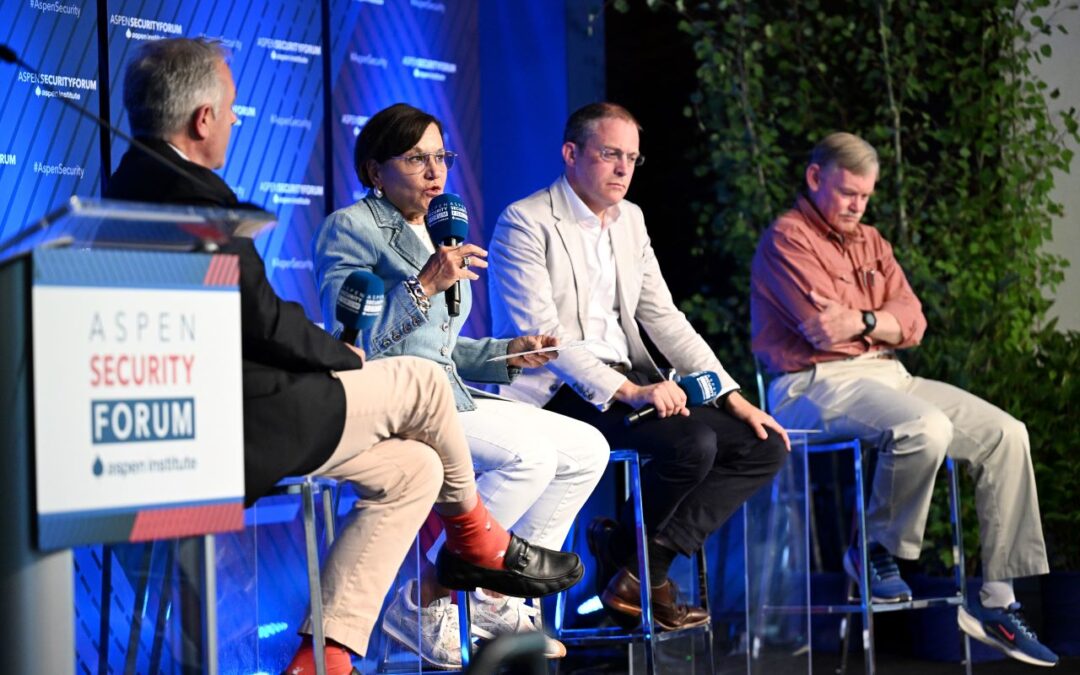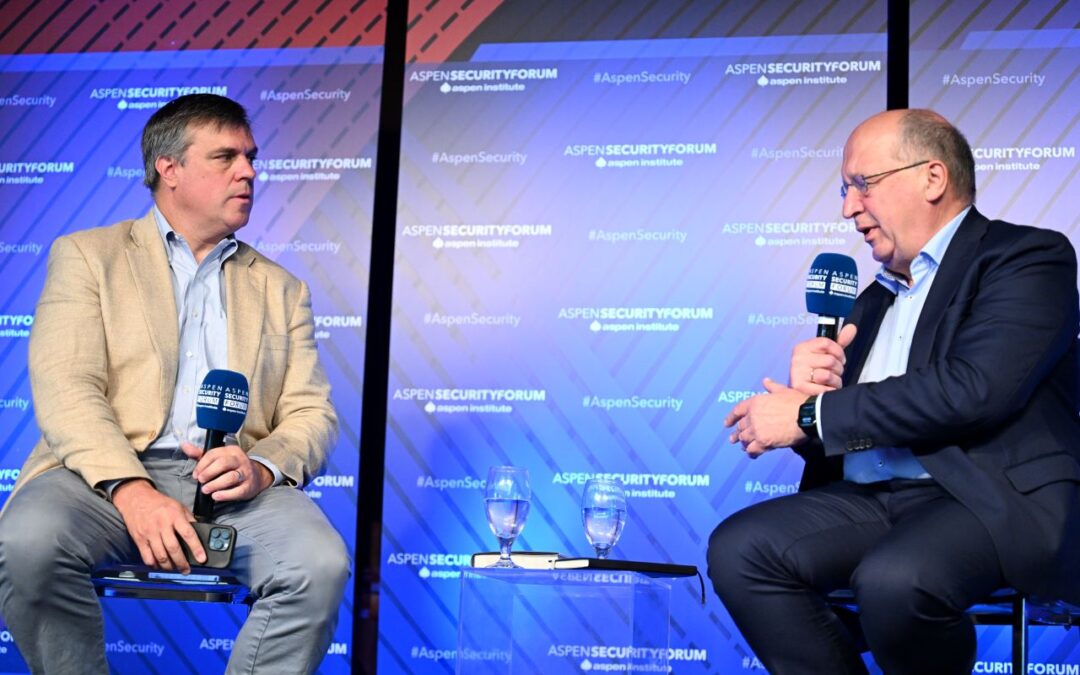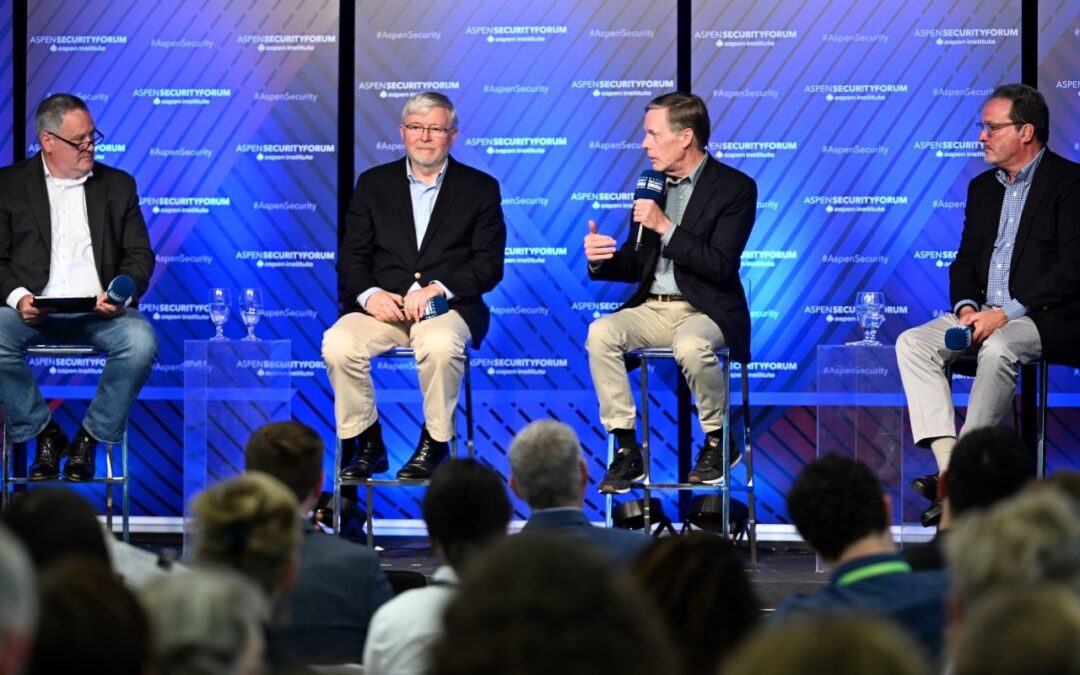Speakers
General Glen D. VanHerck, Commander, North American Aerospace Defense Command and U.S. Northern Command
Moderator: Steve Clemons, Founding Editor at Large, Semafor
Full Transcript
Read the full transcript below or download it to your device.
Click to read the full transcript
Keoki Jackson, MITRE National Security (01:17):
So MITRE is a not-for-profit corporation that, uh, has the mission of solving problems for a safer world. More relevant to today’s discussion. Mir was founded in 1958 to develop the nation’s first automated air defense system for the newly created north American air defense commander. NORRA Nord is integrated, aligned with us Northern command, which was established in 2002 to defend the United States and cooperation with and in support of our allies, partners and civil authorities. I’m pleased to introduce a fireside chat with general Glenn van Huk commander Nora and NORTHCOM general van Huk has served in the United States air force for 35 years with more than 3,200 flight hours as a pilot flight examiner and weapons school instructor. Previously, he served as director of the joint staff at the Pentagon general van Herk will be in conversation today with Steve Clemons, founding editor of SEMA four, a new global news platform, general Steve, the floors, yours
Clemons (02:28):
Joki. Thank you so much that great to be with you. Um, you know, I would tell everybody that one thing I’ll just take off the table real, you know, real quick is, you know, many of, you know, NORRA as the Santa tracker. Uh, I know that I know the, you know, the Santa tracker, something that’s kept NORRA in the news every year, every Christmas, but I, I want to, you know, be serious from when I started my career, uh, as a young guy, many years ago at the Rand corporation at the Rand UCLA center for the study of Soviet international behavior long, it was called SI. And we used to, you know, be, uh, have a facility and talk about arms control, slums gleams ICBMs, and how important, uh, air defense and over the horizon radar and defenses were. And then the Soviet union disappeared. Uh, then Russia seemed to be a friend for a while than it. Wasn’t all that seems to have come back now today. And as it’s come back, I’m in really interested in what your dashboard looks like. And I should tell our audience just to make the point you wear two command hats. You’re a double hated commander with two separate sets of nightmares to worry about. So what does that strategic dashboard look like? And is it bifurcated? And are you when you have your nightmares have to have them on different sides of your brain?
Gen. VanHerck (03:42):
Well, first of all, if I do have a nightmare, it is failing at tracking Santa Claus <laugh> so I can’t can’t have that happen, but, uh, so what, what I like to tell people is the two commands I’m privileged to command two fantastic ones are separate separate lines of authorities, uh, bosses, Canadian side, us side, uh, through the secretary on both of ’em through the chief of the defense staff, to the minister, the prime minister on the, uh, the NORAD side as well, but they’re really inseparable commands. And so as I go about my day to day business, and when I talk here today, what you’re gonna find is I will be wearing both hats. And in the, in the span of a conversation, talk about multiple roles. And you won’t even know when I’m talking as the commander of Nord or the commander of United States Northern command.
Clemons (04:27):
So when you’re in this, you’re sort of thinking about the, the roles and functions you have. What are the up at night issues that you had last night about our safety here in Aspen and around the country?
Gen. VanHerck (04:39):
Well, I sleep pretty good at night, Steve, I I’ll be honest with you and you should too, in all of you, we, we’ve got a fantastic strategic deterrent, the finest conventional forces on the planet. What, what I would tell you challenges us is the unknown. And what I mean by the unknown is domain awareness challenges. The first one I would tell you is undersea domain awareness as competitors develop, uh, capabilities, the challenges of monitoring submarines in the future, uh, will only grow same thing for domain awareness, challenges for hypersonic, uh, missiles, hypersonic, cruise missiles, uh, cyber domain awareness is a significant challenge. So what I don’t know is a challenge. Now, the good news is we’re working to fix this. And the department did a fantastic job in the budget this year, the president’s budget for domain awareness, there’s four over the horizon, radars in the budget. So I look forward to that NORAD modernization minister non just announced their plan with two over the horizon radars for the polar aspect of that in the budget is additional capability for the Navy for undersea domain awareness. So I’m very encouraged, uh, with where we’re going, but we still have some challenges to work on.
Clemons (05:48):
Now just a few weeks ago, uh, an air force general named Glen van HK made this statement. My assessment today is I don’t have what I need as far as artificial intelligence and machine learning to give the decision space to the president, secretary defense, the chief of defense staff in Canada, the minister of defense and the prime minister in Canada. And my understanding was you were asking for about 30 million, which was not, you know, a lot in defense land, but, but do you have what you need? You just gave a compliment to the bite administration that you feel like you’ve made progress, but when it comes to AI, quantum new evolving technologies in this threat, are we, are you where you want us to be?
Gen. VanHerck (06:29):
No, the answer’s, uh, definitely no, Steve, we, we need to go faster in developing these capabilities when I talk domain awareness. Uh, now when you have information and data, the question is how are you gonna process that and disseminate it in a timely manner? So what I’m trying to do is create decision space, decision space equals deterrence options for the president, for the secretary, for the prime minister and the minister in Canada. And the way you do that is through analyzing that data and information, that domain awareness data through the use of machine learning and artificial intelligence, the machines can count numbers of cars and parking, lots numbers of, uh, vehicles and weapons, loading areas, and alerts you to changes today. Oftentimes we don’t use the machines to analyze that data in a timely manner. So I do think we can go faster there.
Clemons (07:14):
How do you test your team and yourself to get away from habits of the mind and practice that may not, uh, see surprises around the corner? In other words, I’m asking a lot of stuff just has inertia built in it. You do tomorrow a little bit like what you did yesterday. But my understanding is that one time nor ad did a simulation and you worried about airplanes becoming weapons before nine 11, 2001, but the rest of the defense system never picked that up. So I’m, I’m interested in how you challenge one’s patterns of thinking and habits creatively so that we can be smarter about security.
Gen. VanHerck (07:54):
Well, you embrace a diverse culture around you, different minds, people who think differently. If you line yourself with the folks that look like you think you like, you act like you and have the same background, you tend to not get a, a, uh, what I would say answers like you’re talking about that are innovative. You rely on academia institutions, you rely on, uh, industry and others, and you challenge them to think about future problems that we may face. Uh, you know, we’re facing problems today. We have to solve those and be ready each and every day to defend our Homeland and have the watch 24 7. But we also need to think about the future. And that’s what we’re doing with our strategy is how do we position ourself for 2030? We have a Homeland defense design for 2030, and don’t think about Homeland defense as being kinetic in game defeat and shooting down cruise missiles over the Homeland.
Gen. VanHerck (08:43):
You know, we don’t want to put a Patriot and a Thad on every corner, but you can utilize the electromagnetic spec spectrum. You can utilize deception capabilities, resiliency, and hardening to do defense differently in the future. I would say it comes down to more than just defense. It comes down to campaigning, which is part of integrated deterrence. And this the department has done a great job with the national defense strategy. Okay. We put our strategy out in December of 20, which was focused on integrated deterrence. And so when you think about defense, what, what I wanna do is get way further left through the innovation and using that data and information to give the president and the secretary decision space to create those deterrents options.
Clemons (09:26):
Do you know, I, I just wanna do this as a sidebar is a lot of important stuff we can get into, but, um, at the end of the Trump administration, uh, and moving into the Biden administration, we had a lot of media and, and press writing about chains of command who had authority to do what did general Millie have the right to, you know, jump into, you know, a command by the president to potentially launch nuclear weapons, et cetera. But there were a lot of questions about process and decision making. And as I told you, when we walked in here, I was an air force bra. I grew up on department of defense installations. My dad was in the air force. I was, I, I very rarely saw messed up decision making process, but we, we did have it in this country. Have, has that been worked out? Were you, were you ever in, uh, a position yourself that you worried about how some of your compatriots were receiving command orders?
Gen. VanHerck (10:15):
No, I, I haven’t been, uh, in a situation where I was concerned about command orders or, uh, potential, uh, compromise of the chain of command. What I would tell you is that the way we do command orders needs to adapt and change because the environment is going faster and faster and to stay relevant as the information and data environment changes, we need to think and use the capabilities, the data that I talked about to collaborate globally on a single pane of glass, to make an assessment globally of the threat, to create deterrence and defeat options globally, and to analyze whether they’re actually executable today. Oftentimes that takes days if not weeks. And it comes to the Pentagon, even at my level, not globally integrated, we can do that much faster and give command orders much faster. Now you’ll have to change the processes and you’ll have to use mission command, which is the delegation of authority, uh, to, to really utilize the speed that we can with data and information in the future.
Clemons (11:16):
Now I’m gonna overstate this for effect, but I’m going to remind you of something that I think you’ve said in the past that we have a big blind spot in how we look at regional security in the United States and in the, in north America, that, that, that a threat that happens here is, is not just regional. And we don’t need just regional decision makers. It has global consequence global impact that needs global response. So can you tell us what that means? Can you unpack that?
Gen. VanHerck (11:42):
Well, Steve, there, there are no regional problems anymore, so China is not. So,
Clemons (11:47):
And we have a lot of regional commands.
Gen. VanHerck (11:49):
Yeah, we absolutely do. And those are gaps and seams that can be exploited. And so what I’m talking about is collaborating globally in real time across those gaps and seems for not only the geographic combatant commanders, but the functional combat commanders. So we have a global picture. We do need to change. I think how we, uh, do our strategies, our plans, the way we do global force management, theater, security, cooperation, et cetera, exercises. So let me tell you our strategies and no plans for the most part, start off with a regional crisis or conflict. And we build them out, utilize the joint force from a regional perspective. Uh there’s there are no regional problems anymore. China will be a global problem is a global problem today. And so I would rather start off with a global perspective with the secretary providing, uh, global risk global resources where he will not accept risk globally, apply the joint force to that problem set, and then create your regional plan.
Gen. VanHerck (12:45):
Today. We do it just the opposite backwards on global force management. The, the joint force is not nearly large enough to do everything that we would like to do, but we need to think about force management and sharing forces differently across those gaps. And seems those lines you talk about in addition to that, we have an opportunity to, to utilize global force management, which today is done separately from exercises, which is done separately from theater, security, cooperation, all of those activities, investments, operations exercises have a deterrent value when message properly. And so we have to think about those as a whole, from a global and all domain perspective.
Clemons (13:26):
So you just tested some of those seams and the assumptions and biases that are built into security. And I have to say, I bet if we pulled this room about what nor ad’s chief obsession was, it would be over the horizon Northern hemisphere threats, but you’ve also gotta worry about the south. Can you tell us a little about operation noble defender, what you learned and, and, and, and how we’re prepared for, for threats from the south as well as the north?
Gen. VanHerck (13:55):
Well, we just completed a noble defender demonstrating capability to look south, uh, China’s recent, uh, fractional orbital bombardment test, which
Clemons (14:05):
Can you just tell me what that means in like
Gen. VanHerck (14:07):
Speed, speed language. That was, that was the ICBM. They launched it. Okay. Orbited the,
Clemons (14:11):
So that’s a hypersonic. It
Gen. VanHerck (14:13):
Orbited the globe with a hypersonic that re-entered the atmosphere at mock 19, uh, from the south and flew, uh, across the Pacific ocean in landed in China that came from the south. We’re challenged with having sensors to, to look to the south today. Noble defender is part of my campaign plan to demonstrate our readiness capability, our resiliency, to operate from all a axis threats that come to the Homeland. That’s what the noble defender is
Clemons (14:39):
And, and what, you know, given that experiment and what we did, you know, as you look at the future of what you need from Washington DC, what, what do you need to amp up? You know, the, the muscular infrastructure on that front?
Gen. VanHerck (14:53):
Well, the president’s, budget’s sitting with Congress right now to appropriate funds for that. I need him to appropriate the funds for the over horizon radars to support the undersea domain awareness that, that we’re talking about, uh, additional Arctic infrastructure, capabilities, communication capabilities, those things. So we can compete, uh, in the Arctic. My AOR goes all the way from the north pole to central America, and we have to be able to operate across all of those areas. I do think we have opportunities to change the way we acquire capability. Uh, we’re, we’re an industrial age based process in the department built on buying ships, planes, airplanes, those kinds of things in today’s digital world data world. Uh, we need to go faster and develop in those. And I think you can accept a little more risk, do things more in per parallel, not necessary, uh, serial, uh, and field things much quicker. I, I think there’s opportunities
Clemons (15:46):
Does, does your, I don’t mean to interrupt, but John, does your gut feel to tell you that that’s the direction we’re going? Cuz you know, you’ve been a very loud voice saying we need information dominance, we need faster movement we need. And so my sense is you’re, you’re pounding both on your fence at the Pentagon and on Congress to do this. Do you feel it’s going that way?
Gen. VanHerck (16:06):
Absolutely. I’m doing exactly what you just said. I do think it’s going the right direction. Uh, the vice chairman, the deputy secretary have been very aggressive with providing funds for innovation capabilities, to the combatant commanders. Uh, the budget has additional capabilities in it for joint, all domain command and control. That’s a lot of what I’m talking about, but I do think there’s other things you ask, what can we do in Washington, DC? You know, our, our five up spread over five years with annual budget and the colors of money, um, very hard to move money around in the year of execution. And I totally respect Congress’s oversight role, but you know, when you’re updating your software every four day, 14 days and a digital environment, you can adapt quickly. We have to look at the policies and laws that don’t allow us to go as fast as we need to go in the environment we’re in today.
Clemons (16:52):
You know, we, we had on stage earlier today, uh, Richard Moore, who’s the head of I six in the UK. Uh, he made a statement that maybe we’re hyping some of the threats too much, that the Chinese are not 10 feet tall. Uh, the Russians may be depleting themselves, uh, which I understand as a perspective, but from a, from a perspective of looking at threats and you’re, I’m, I’m sure that you are a target of a lot of interest by those in China and Russia, trying to penetrate your world. What is your sense of how tall the Chinese are and how depleted the Russians are?
Gen. VanHerck (17:24):
Let me just say first we, we have the most powerful military on the planet. There’s no doubt about that, but the Chinese want to displace us and they’re on a path to gain significant capability. They’re modernizing their nuclear forces at a, at a rapid rate. They’re developing conventional capabilities. We see that with their hypersonics. And so they’re on a path to approach, uh, a peer status with us. I, I want to talk about Russia. Okay. I don’t wanna, uh, say that, you know, Russia has, uh, failed, uh, they have struggled in the land domain. Uh, what I would tell you is in their, uh, conventional capabilities, their long range standoff capabilities, uh, they they’re displaying significant capability. That’s the threat that I worry about to the Homeland. So I would not undersell Russia. And I would not say China is 10 feet tall right now, but they do certainly have aspirations to compete at a peer level with us.
Clemons (18:14):
You know, you made an interesting statement and I, and I have to admit that I don’t fully understand it, but, but my, my sense is that you are worried that the Russians or other, um, uh, origins of threats may try to use non-traditional things, you know, maybe not ICBMs or cruise missiles over the horizon, but other elements that we’re not prepared for, uh, to threaten our security. And it reminded me of something that Russia has been trying to animate in places like Latvia, you know, going there and, you know, animate weaponized migration because it’s really not in the NATO defense book on how to protect latian political stability from migration on its border. But you were saying there are non-traditional things that, that, um, our rivals could do that we don’t have a playbook for. Can you share a little bit, you know, about that with
Gen. VanHerck (19:02):
Us? Well, first of all, we’re under attack every day. Let me be clear about that in the information space, uh, our strategic competitors, potential adversaries fan, the flames of internal strife and discord in our country to expand that, to undermine our democracy that is happening every single day in the cyber domain, we’re under attack O on a day to day basis. But what I’m talking about is cyber kind of capabilities to limit our power projection, to delay and disrupt our force flow in a regional crisis or to destroy our will. And their goal would be to think they could prevent us from entering a regional crisis. That’s one, if you look at what COVID did and the pandemic itself, and you saw how it, uh, significantly, uh, had impact economically on large nations, et cetera, you know, I worry in the future about the potential for biological pandemic type of, uh, weapons. Those are things that we have to look at and ensure that we’re not, uh, positioning ourself to be vulnerable to those kind of threats,
Clemons (20:02):
Do Russia and China have their own version of a nod. I know not, you know, north American of course, but their own sort of facility that, that, that approximates the kind of security provision that you do.
Gen. VanHerck (20:14):
I wouldn’t say they have anything like nod by, by the way, our asymmetric advantage is our network of allies and partners. Okay. China and Russia don’t have that. They do have air defense centers, air defense sectors in their other countries. Uh, they have significant integrated air and missile defense systems, uh, to defend their Homeland as well.
Clemons (20:32):
What, if you can say this, I’m not sure you can with the president’s budget there, but I feel like you’re a pretty candid guy. What are Washington’s biggest blind spots about the challenges you have?
Gen. VanHerck (20:43):
Well, the first thing I would say is, uh, and, and one of the reasons that I’m here speaking to you is understanding the threat to the Homeland. You know, there’s a perception out there by many held and for good reason, for many decades, we could project power from the Homeland to any place at our own time, uh, and, uh, place of choosing that’s no longer the case, you know, two big moats on each side, the Atlantic and the Pacific ha have served us well, but now capabilities are being developed to utilize those. Russia’s the primary military threat to the Homeland today, they’re an acute threat, but the long term existential threat is the Chinese. And they’re developing capabilities about five to 10 years behind Russia, conically to hold our Homeland at risk. Uh, today they hold the Homeland at risk cyber and certainly in space capabilities and the information, uh, space as well.
Clemons (21:30):
You wrote a piece with, um, a person who’s a general who’s head of, I think, us transportation command saying fighting to get into the fight. And you have a lot of worry that we have layered a lot of barriers to be able to handle those threats to infrastructure in the Homeland. How would you fix it? What’s the short form way to fix it?
Gen. VanHerck (21:49):
Well, we’re on our way to fixing that. And the first thing I would say is we need to do the analysis and figure out what we must defend, uh, that could bring us to our needs to prevent our force flow in a time of crisis.
Clemons (22:01):
So this along the lines of colonial pipeline or other issues along
Gen. VanHerck (22:03):
Those lines. Yeah. So these are the single points of failure or things that we would rely on in a time of crisis to flow the forces. The good news is, uh, for the last two years, I’ve been in command. I’ve been talking to the department about this and the department has moved this ball way down the field, and I have policy, but it’s just not D O D. We have to have, have a whole of nation discussion about the vulnerabilities. We have some of the challenges that we have. First of all, I don’t believe that Russia or China’s gonna attack us out of the blue kin, genetically, uh, that that’s something that, uh, I don’t fear I don’t look at, but I do believe in a time of crisis, they would start with non-kinetic activities to attempt to disrupt us. Now, what’s crucial about this.
Gen. VanHerck (22:41):
And everybody needs to understand is that the vast majority of our critical infrastructure that we rely on to de deploy those forces in a timely manner is not in D O D or even federal, uh, control and for protection. It relies in municipalities state, uh, industry, et cetera, that we rely on. So those are unknown spots for me. And I, I heard in the prior panel, there were, we, uh, I think it was, uh, Michelle Flo talking about, uh, companies who are afraid to admit they may be vulnerable or have been exposed. Those are blind spots that we’ve gotta fix. You
Clemons (23:14):
Know, we have a lot of people watching online and out in a cooler area on screen right now, some of them are super experts on national security and foreign policy. And some of them are lay. People are just interested in knowing how the world’s putting itself together and where it’s going. What do you think are the some, so talk to the lay person right now. What are some of the most important misconceptions that they may have inadvertently about our security?
Gen. VanHerck (23:38):
Well, I just mentioned one that, that we’re a sanctuary or we’re safe here. Uh, we can’t be attacked on our Homeland. We’re actually being attacked every day in the information in cyberspace. Uh, I, I, I would say that’s the first one, the, the misperception about that.
Clemons (23:54):
And I would say just as we finish up soon here, um, the panel coming up next, which I also have, the privilege of moderating is, is gonna get into the, the question of what can fiction or what can interesting out of the box collaborations with, you know, games makers and, you know, movie production facilities and fiction writers do to broaden our mind or to change, contribute to national security. And, and I ask this hesitantly, you know, because, you know, my last real reflection on NORRA in pop culture was around 1981. And it was war games with Matthew Brodrick. I dunno if you let Matthew Brodrick in, on the property anymore, but, but, you know, so when you look at that and, and you think about fiction, is that a U is, is our next panel useful to you in any way at all?
Gen. VanHerck (24:40):
Absolutely. So, uh, I, I recently, uh, wrote an article and I, and I believe I testified to the same, same thing. Innovation, uh, is something that we need and letting industry or academia’s minds run wild about how to solve the problems that we face every day is good. I talked about surrounding yourself with people that think like, you act like you, you don’t get that innovation of where you’re going. And so what you’re talking about is war gaming, innovative, uh, and thinking about the problems differently than we do today. I welcome that and look forward to that panel.
Clemons (25:14):
And in our last minute, I’m gonna ask you another question, cuz this is sort of a, non-traditional part of security of the Homeland and the Northern command, but the Pentagon and all of its many appendages have a huge impact on what we do as a nation and as a world to deal with climate change and changing, uh, uh, uh, environmental factors that are impacting people around the world. And I know that the department of defense has put it out to security, but just be interested as a security, uh, equation here. As you think of climate in your Northern command hat, what are the, uh, issues for you there?
Gen. VanHerck (25:49):
Well, it affects me both my Northern command and Nora hat. Okay. So as climate change,
Clemons (25:55):
Is there anything that doesn’t affect both hats?
Gen. VanHerck (25:57):
There, there are some things you’re gonna put me on the spot. Let me answer this question for you. Okay. So what’s, what’s going on. Absolutely climate change is happening. It’s creating opportunities and it’s creating vulnerabilities. The question is, what are we gonna do for both of those as the sea smelts, you know, commerce can now travel much quicker through the, uh, the north, you have access to more resources what’s happening is just, as you see what’s happening in Ukraine with Russia’s irresponsible and illegal behavior is they’re trying to change the norms and the rules that have existed since the end of world war II. And China’s right on their Hills. We’re gonna see friction in the Arctic based on resource challenges and, and land claim, uh, under seabed claims those types of things. And so we have to be present. We have to be there to ensure that we have stability as we go forward in the Arctic.
Clemons (26:47):
I just want, thank you so much. You filled out much that we, uh, did not know about the role of Nora in the Northern command. Please give a round of applause to general Glen van, her commander of the north American aerospace defense command, Nora and commander of us Northern command. Thank you very much, sir, sir. Really appreciate it. Thank you.



